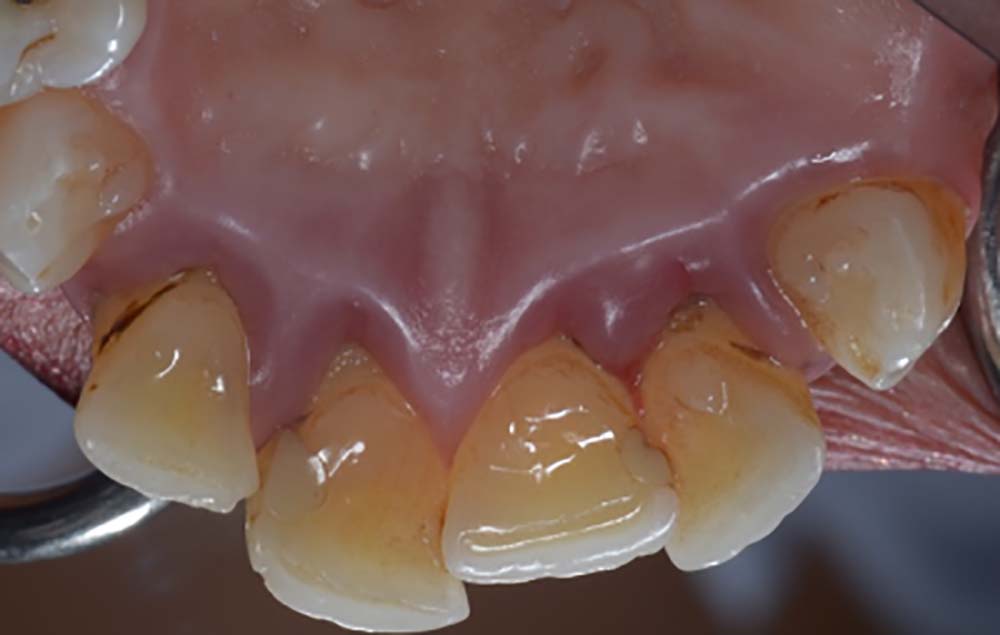Periodontitis or “gum disease” is a term that describes inflammation that causes a progressive damage of the gums, ligaments, and bone that hold the teeth in your mouth.
Over time, this damage can result in “pockets” of gum tissue around the teeth which provide spaces for bacteria to live.
Gum disease has many stages, often starting with “gingivitis.” Gingivitis is less destructive, but like gum disease it is caused by inflammation from the bacteria in the film (plaque) and deposits (tartar) left on the teeth.
SYMPTOMS
Common symptoms include:
- Gums that are red, tender, swollen, or bleed easily
- Teeth that are loose, sensitive, or shifting
- Bad breath
- Painful chewing

WHEN TO SEE A DENTIST
Whether you have symptoms of gum disease or not, it is generally recommended to see your dentist or dental hygienist for a checkup and cleaning at least every 6 months.
If you have any of the symptoms described above, contact your dental office or School of Dentistry provider as soon as possible to set up an appointment. Even light bleeding from your gums may indicate an underlying issue.
RISK FACTORS
The following are risk factors you can change:
- Home oral care practices (brushing/flossing)
- Routine dental checkups
- Tobacco use
- Diabetes control
- Obesity
- Alcohol consumption
- Diet/Nutrition
Still, there are several risk factors leading to periodontitis that you cannot change:
- Family history
- Your body’s response to infection/inflammation
- Conditions like osteoporosis
- Age
COMPLICATIONS
Failure to address periodontitis may result in one or more of the following complications:
- Receding gums
- Tooth shifting
- Tooth loss
- Difficulty chewing
- Difficulty controlling a range of systemic diseases due to associations between oral health and general health (diabetes, cardiovascular disease)
PREVENTION
Follow the guidelines below to best combat periodontitis:
- Brush your teeth twice a day for two minutes each time
- Clean between your teeth every day with floss or other approved device
- Practice good self-care (eat a balanced diet, manage stress, get rest)
- Manage systemic conditions and diseases (cardiovascular disease, diabetes)
- Avoid all tobacco products (as well as marijuana)
- See your dentist and dental hygienist regularly for checkups and routine care
AVAILABLE TREATMENTS
The goal of gum disease treatments center on the removal of the bacterial plaque and tartar from below the gums in order to restore health to the oral tissues and ultimately reduce the size of the “pocket.” There are several ways this is done depending on individual patient needs.
NON-SURGICAL TREATMENTS
Gingivitis is reversible. It can usually be treated with routine daily brushing/flossing, good self-care, and regular cleanings with your dental hygienist.
Gum disease causes irreversible damage to the oral tissues. Treatment recommendations will vary depending on the stage and severity of disease and concurrent risk factors. Treatment may take place over a series of several visits.
Initial treatments of earlier stages of gum disease are generally completed by a dental hygienist. The procedure might be referred to as a “deep cleaning,” “debridement,” or more formally as a “scaling and root planing (SRP).” No matter the terminology, the main action is the removal of bacterial plaque and tartar from your teeth (scaling) and the smoothing of the tooth roots (planing) above and especially below the gum line.
Ultimately, the goal of SRP is to decrease the bacteria/infection around the gums in order to disrupt the progress of the disease and promote healing.
Additional support may be provided through patient education and may include; special brushing/flossing techniques, therapeutic mouth rinses, nutritional counseling, and health behavior modification.
It can take many weeks after a SRP for gums to restore to a healthier state. You should experience less bleeding and tenderness in your gums. However, your teeth might be sensitive to extreme temperatures. This sensitivity should be temporary and it can be helped by keeping the teeth clean and using sensitivity toothpastes, mouth rinses, or fluoride products.
Results of any treatment depend on several factors including; home care compliance, personal health behaviors, and keeping appointments with your dental provider.
Follow up visits will be scheduled based on your individual needs. Some individuals can maintain their stage of gum disease with routine “periodontal maintenance” appointments. Others may need more advanced treatment and will be referred to a periodontist or “gum specialist.”
SURGICAL TREATMENTS
Non-surgical treatments do have limitations. If the “pockets” are not sufficiently reduced after the SRP treatment, a periodontist may recommend surgery.
Below the gums, teeth surfaces have many irregularities where plaque, tartar and bacteria can hide. In deeper “pockets” these can be difficult for the clinician to access with their instruments. Therefore, a surgical treatment by a periodontist may be needed.
The most common gum surgery will involve “folding back” the gum tissue to access the hard to reach areas and underlying bone. This is commonly called “flap surgery.” Deposits are removed and roots are smoothed. Bone can even be reshaped. The gum tissue is laid back over the original position. Stitches are placed and remain for about two weeks.
Complications after surgery can include bleeding, pain, and infection. Lasting effects can include tooth sensitivity and gum recession.
Results of gum surgery have relatively high success rates, but depend on factors such as good self-care, tobacco cessation, and compliance with maintenance therapy.
After surgical treatments are complete, your periodontist will work with your dentist to manage your “periodontal maintenance” cleaning appointments. Sometimes you will alternate visits between the dentist and periodontist offices.
CONTACT
Start by scheduling a visit with your dentist or dental hygienist or School of Dentistry provider. They can assess your oral condition and unique risk factors, discuss treatment options, and make referrals to specialists, if needed.

